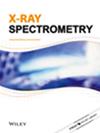Francis Williams: Shedding light on the production, materials and techniques of the portrait of a Jamaican scholar
IF 1.5
4区 物理与天体物理
Q3 SPECTROSCOPY
引用次数: 0
Abstract
The Victoria and Albert Museum holds an important portrait of the Jamaican scholar and writer Francis Williams (c.1692/97–1762), portrayed as a scholar in his study. It is believed to have been painted around 1745 by an unknown artist, but the circumstances of its production are unknown. A technical examination of the painting was performed using x‐radiography and infrared reflectography (IRR), macro x‐ray fluorescence scanning (XRF), digital microscopy, scanning electron microscopy with energy‐dispersive x‐ray spectroscopy (SEM–EDX) and reflectance imaging spectroscopy in the short‐wave infrared (SWIR). XRF, IRR and reflectance imaging spectroscopy in the SWIR revealed the distribution of inorganic pigments including lead white, earth pigments, Prussian blue, vermilion, orpiment (or pararealgar) and bone or ivory black. Pentimenti and a different sketched landscape were observed in the IRR images, highlighting changes in the final composition. Three‐dimensional (3D) digital microphotography provided additional historical and contextual information through the observation of book titles and details. High‐resolution digital imaging complemented analytical data. Results of the technical examination revealed the material composition and the development of the painting, contributing to shed new light on the production of the portrait, the history and significance of the portrait.弗朗西斯·威廉姆斯:揭示牙买加学者肖像的制作、材料和技术
维多利亚和阿尔伯特博物馆收藏了牙买加学者和作家弗朗西斯·威廉姆斯(约1692/97–1762)的重要肖像,他在书房里被描绘成一位学者。它被认为是1745年左右由一位不知名的艺术家绘制的,但其制作情况尚不清楚。使用x射线照相和红外反射成像(IRR)、宏观x射线荧光扫描(XRF)、数字显微镜、具有能量色散x射线光谱(SEM–EDX)的扫描电子显微镜和短波红外反射成像光谱对该画作进行了技术检查。SWIR中的XRF、IRR和反射成像光谱揭示了无机颜料的分布,包括铅白色、地球颜料、普鲁士蓝、朱红色、雌黄(或副雄黄)和骨或象牙黑色。在IRR图像中观察到Pentimenti和不同的素描景观,突出了最终构图的变化。三维(3D)数字显微摄影通过观察书名和细节提供了额外的历史和背景信息。高分辨率数字成像补充了分析数据。技术审查的结果揭示了这幅画的材料组成和发展,有助于揭示这幅肖像画的制作、历史和意义。
本文章由计算机程序翻译,如有差异,请以英文原文为准。
求助全文
约1分钟内获得全文
求助全文
来源期刊

X-Ray Spectrometry
物理-光谱学
CiteScore
3.10
自引率
8.30%
发文量
38
审稿时长
6-12 weeks
期刊介绍:
X-Ray Spectrometry is devoted to the rapid publication of papers dealing with the theory and application of x-ray spectrometry using electron, x-ray photon, proton, γ and γ-x sources.
Covering advances in techniques, methods and equipment, this established journal provides the ideal platform for the discussion of more sophisticated X-ray analytical methods.
Both wavelength and energy dispersion systems are covered together with a range of data handling methods, from the most simple to very sophisticated software programs. Papers dealing with the application of x-ray spectrometric methods for structural analysis are also featured as well as applications papers covering a wide range of areas such as environmental analysis and monitoring, art and archaelogical studies, mineralogy, forensics, geology, surface science and materials analysis, biomedical and pharmaceutical applications.
 求助内容:
求助内容: 应助结果提醒方式:
应助结果提醒方式:


